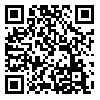Volume 20, Issue 2 (Paramedical Sciences and Military Health 2025)
Paramedical Sciences and Military Health 2025, 20(2): 48-64 |
Back to browse issues page
Download citation:
BibTeX | RIS | EndNote | Medlars | ProCite | Reference Manager | RefWorks
Send citation to:



BibTeX | RIS | EndNote | Medlars | ProCite | Reference Manager | RefWorks
Send citation to:
Tavosi Nikabadi F, Esmaeil Zali M. Pathology of Gender Inequalities and Learned Helplessness among Iranian Women. Paramedical Sciences and Military Health 2025; 20 (2) :48-64
URL: http://jps.ajaums.ac.ir/article-1-477-en.html
URL: http://jps.ajaums.ac.ir/article-1-477-en.html
1- General Psychology, Islamic Azad University, Roudehen, Tehran, Iran.
2- Hospital Management, Department of Health Care Management and Economics, Faculty of Medical , AJA University of Medical Sciences, Tehran, Iran. ,zali1357@ajaums.ac.ir
2- Hospital Management, Department of Health Care Management and Economics, Faculty of Medical , AJA University of Medical Sciences, Tehran, Iran. ,
Abstract: (134 Views)
Introduction: Gender inequality, rooted in social and cultural structures, creates widespread limitations and discrimination against women, leading to learned helplessness-a state where women believe they cannot change their circumstances, resulting in extensive psychological and social consequences. This study aims to analyze gender inequalities and learned helplessness among Iranian women.
Materials and Methods: This qualitative research, based on an interpretive paradigm, employed thematic analysis. The statistical population consisted of 13 experts with comprehensive knowledge of the subject and diverse cultural, social, and economic backgrounds, selected through purposive sampling. Data were collected via semi-structured in-depth interviews, then coded, classified, and themes extracted through thematic analysis. Data validity was confirmed through credibility, transferability, dependability, and confirmability.
Results: Seven overarching themes were identified, including legal discrimination, educational deprivation, legal violence, cultural violence, employment discrimination, ownership restrictions, and medical limitations. Additionally, 27 concrete manifestations of gender inequality, 27 behavioral patterns of learned helplessness, 18 harms, and 18 psychological interventions related to gender inequality and learned helplessness among Iranian women were extracted.
Conclusion: Gender inequality and learned helplessness among Iranian women form a self-perpetuating cycle rooted in legal, cultural, and social structures, profoundly impacting mental health, social participation, and national development. Effective solutions require psychological interventions alongside structural and legal reforms.
Materials and Methods: This qualitative research, based on an interpretive paradigm, employed thematic analysis. The statistical population consisted of 13 experts with comprehensive knowledge of the subject and diverse cultural, social, and economic backgrounds, selected through purposive sampling. Data were collected via semi-structured in-depth interviews, then coded, classified, and themes extracted through thematic analysis. Data validity was confirmed through credibility, transferability, dependability, and confirmability.
Results: Seven overarching themes were identified, including legal discrimination, educational deprivation, legal violence, cultural violence, employment discrimination, ownership restrictions, and medical limitations. Additionally, 27 concrete manifestations of gender inequality, 27 behavioral patterns of learned helplessness, 18 harms, and 18 psychological interventions related to gender inequality and learned helplessness among Iranian women were extracted.
Conclusion: Gender inequality and learned helplessness among Iranian women form a self-perpetuating cycle rooted in legal, cultural, and social structures, profoundly impacting mental health, social participation, and national development. Effective solutions require psychological interventions alongside structural and legal reforms.
Type of Study: Research |
Subject:
full articles
Received: 2025/05/12 | Accepted: 2025/06/9 | Published: 2025/06/30
Received: 2025/05/12 | Accepted: 2025/06/9 | Published: 2025/06/30
Send email to the article author
| Rights and permissions | |
 |
This work is licensed under a Creative Commons Attribution-NonCommercial 4.0 International License. |




